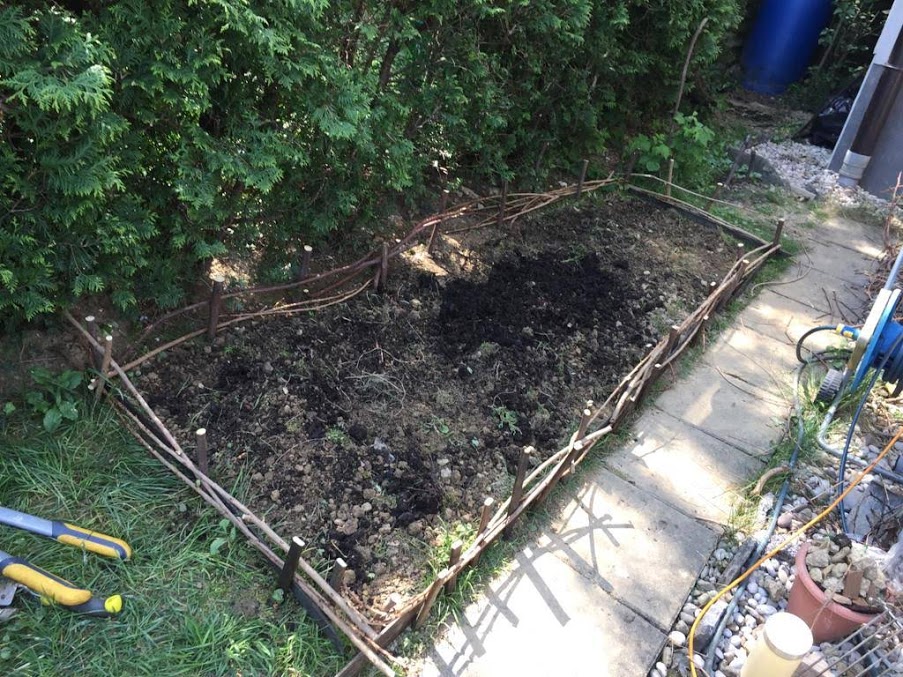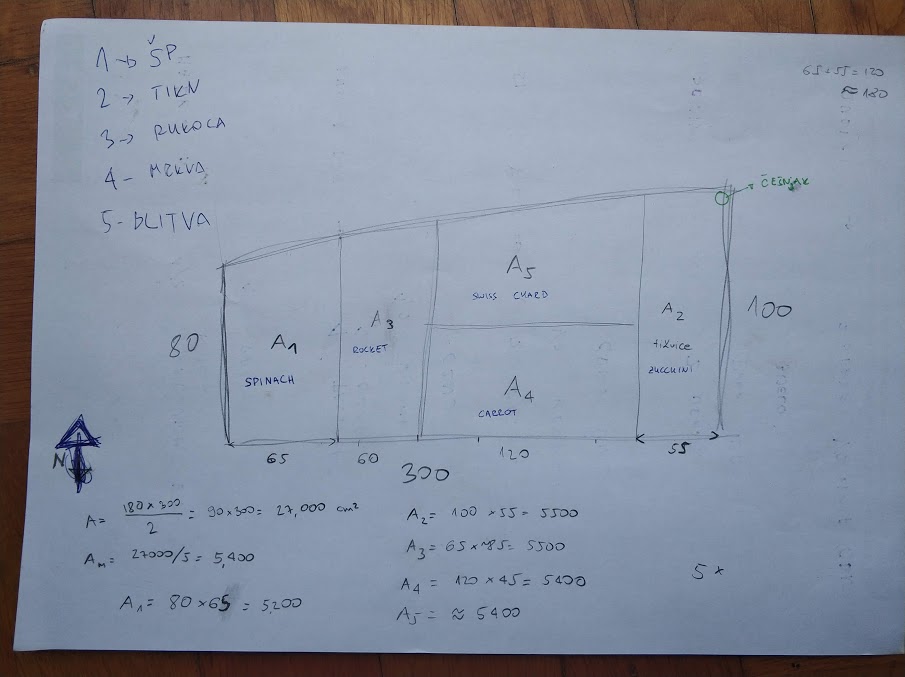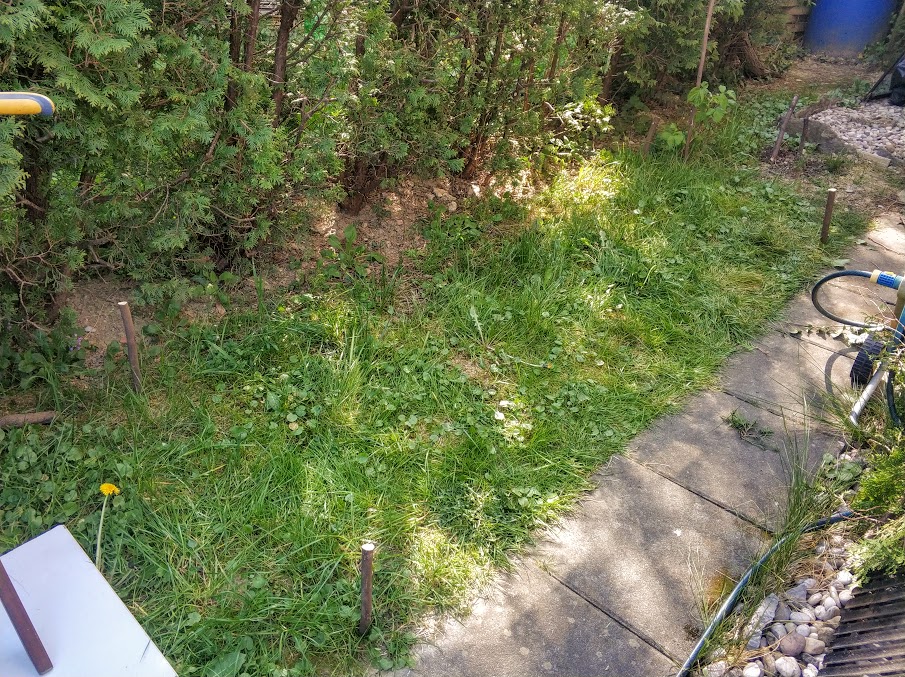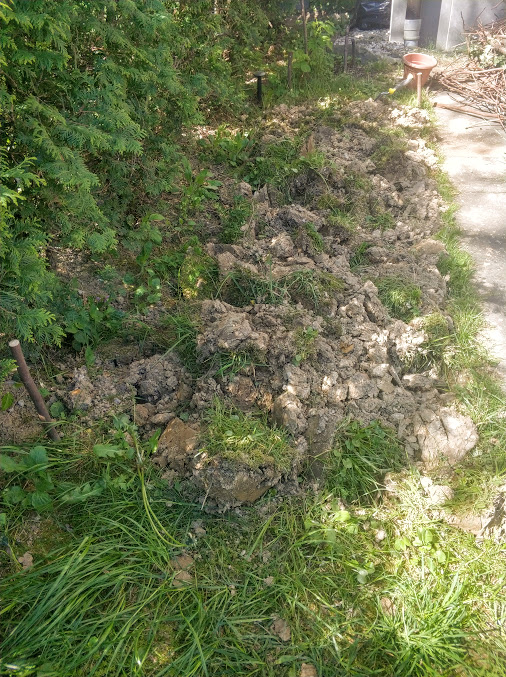TCN Put Me on Corona Gardening Leave: Part 2
May 9th, 2020 - In a series of articles on Total Croatia News read about how one of the authors decided to spend her corona-caused gardening leave - actually gardening. Today, you can find out more about how the soil was prepared and seeds sowed (you can read the first article in the series here).
If you know anything about gardening or plants in general, after having seen my photos and reading my description of the soil in which I planned, to put those seeds, you must've asked yourself a version of this question "Is she insane!?!?", followed by "Well, nothing is coming out of that horrible soil, she's working for nothing here..."
Well, allow me to comfort you: I know. I know that there's no way anything would succeed in such bad soil, no matter how many days I spend taking rocks out one by one by hand. And, coincidentally, I have exactly what I need to turn my soil into normal, fertile soil. I have compost which has been created in my back yard. You might've noticed in the previous article a large, blue barrel in the corner of my yard (you can also see it in the first photo in this article), that's where the compost gets made. We've been collecting our biodegradable waste for years, much longer than the city of Zagreb has had an organized collection of such waste in brown bags. During everyday cooking, the biodegradable waste gets deposited into a used ice-cream container (of course you can purchase a container just for that, the only requirement is for it to have a decent seal of the lid, but if you continue following this series you will discover that it's important to me NOT to buy new stuff if at all possible, rather use the stuff already lying around and repurpose it if at all possible). The container is in the fridge and its contents get dumped into the blue bucket outside every couple of days. After the mowing, that's where the grass also goes, the leaves from the trees in the autumn and any other biodegradable waste which we happen to have during the year. The bucket has a small door near the bottom, and that's how we take the compost out, hi-quality, perfect natural compost, ideal for the grass I keep mentioning or some of the herbs I regularly have on my shelves. This year, obviously, most of my compost went into the garden. I can't even tell you how much of it we took out of the bucket and put into the soil, but you just have to take my word when I tell you it was a lot, and that I really believe we won't have any problems with the soil quality after that.

And after having dropped all of that compost, chopped it up and prepared the soil nice and neatly, of course, the soil level rose a bit and it started looking like the soil would get washed away, onto the tiles just below it. I have to say I anticipated that, so I knew in advance a little fence would be required to prevent that from happening. Good thing I still have a lot of leftovers from a former fence I needed to take down, and a partner who owns an electric saw and isn't afraid to use it. We built the little fence fast enough, and I'm still proud of it - and happy to report that it was able to do its job through the heavy rains that have fallen in Zagreb since, after a long drought.
I mentioned in the previous article that I've purchased parsley, carrot, swiss chard, spinach, rocket and zucchini seeds. Parsley doesn't go into this little patch of garden, it is already growing nicely in a separate container where I have my herbs, where this year it will hang out with some lovely basil. They're in the pot together, I've used some leftover nylon to build them a little greenhouse and they're doing OK.
That leaves five species, meaning I need to create 5 sections in my garden. It took some drawing and calculating and tailoring, but eventually, I settled on this plan:

(This is exactly how a normal person would do their plan for their 3 square meters garden, right?) The zucchini needed to go to one of the edges, so if I get any zucchini, they can grow partially on the outside as well. I concluded that the carrot should be by the hedge, and I'm entirely certain there was a reason why I wanted the spinach to be where it is in the drawing, but I can't remember that now. The rocket and swiss chard positions have been determined completely randomly. I measured my little garden, partitioned it using the already-mentioned pieces of the fence into even smaller parts and carefully, according to the instructions, sowed my 5 vegetables.
And that should be it, right, the only thing left for me to do is water the garden and wait for the plants to start appearing. Or can I think of something else which will improve their chances? Read in the upcoming article.
Pandemijsko vrtlarenje usred grada Zagreba: 2. dio - Sjetva
8. 5. 2020. - U seriji članaka na Total Croatia News stranici na hrvatskom jeziku čitajte kako se autorica odlučila i provela pandemijsko vrtlarenje usred grada Zagreba (prvi članak iz serijala); danas su na redu priprema zemlje i sjetva.
Ako znate išta o vrtu, odnosno biljkama uopće, nakon što ste vidjeli ove moje fotke i pročitali opis zemlje u koju sam planirala posijati to sjeme, sigurno ste se zapitali neku varijantu pitanja: “Pa dobro, jesi ti normalna?!”, na što se nastavilo “A tu joj ništa neće niknuti, u takvoj lošoj zemlji, džaba se uopće jadna trudi…”
E, pa, dopustite da vas malo utješim: znam. Znam da nema šanse da iz ovakve očajne zemlje išta uspije izrasti, koliko god dana ja provela rukama vadeći kamenje. A i, sasvim slučajno, imam i točno ono što mi treba da od te zemlje napravim – normalnu, plodnu zemlju. Imam kompost koji je nastao u mom dvorištu. Možda ste u nekoj od fotografija u prvome članku vidjeli plavu veliku kantu u samom uglu mog dvorišta (a možete je vidjeti i u prvoj sljedećoj fotografiji), tamo raste taj kompost. Radimo ga već godinama, daleko prije nego je grad Zagreb osigurao odvojeno prikupljanje bio-otpada. Tijekom normalnog kuhanja bio-otpad skupljamo u jednu posudu od sladoleda (naravno da se može kupiti i posebna posuda samo za to, s dobro prijanjajućim poklopcem, ali budete li pratili ovaj moj serijal, brzo ćete shvatiti da je meni prilično bitno u životu ne kupovati nove stvari za svaku prigodu, nego koristiti ono što se ima pri ruci i snaći se s time), napuni se svakih par dana pa je ispraznimo vani u plavu kantu. U nju, naravno, ide i pokošena trava, lišće koje s naših stabala padne u jesen i sav drugi bio-otpad koji se stvori tijekom godine. Kanta na dnu ima vratašca kroz koja se onda jednom godišnje otprilike izvadi mnogo kvalitetnog, zdravog komposta, savršenog za onu travu koju stalno spominjem, ili malo začinskog bilja koje redovito imam u dvorištu. Ove godine, jasno, gotovo sav kompost otišao je na moj vrt. Ne mogu vam čak niti reći u kilogramima koliko smo ga izvadili i ubacili, ali vjerujte mi na riječ da je bilo mnogo i da stvarno vjerujem da nakon toga kvaliteta zemlje ne bi trebala biti problem.

A onda kad smo bacili sav taj kompost i sve to fino usitnili i pripremili, jasno da se razina zemlje nešto podigla i da je počela prijetiti da će se „slijevati“ po opločnicima pokraj, u smjeru kojih ima pad. To sam, moram se pohvaliti, zapravo i anticipirala, pa sam unaprijed znala da će trebati napraviti ogradicu. Sreća da imam još mnoštvo ostataka od svoje stare ograde koju sam morala skinuti, te partnera koji ima ubodnu pilu i nije ga strah upotrijebiti je, pa smo relativno brzo izradili ogradicu. Još sam uvijek jako ponosna na nju i mogu vam prijaviti da, nakon ovih ozbiljnih kiša koje su pale u Zagrebu nakon duge suše, stvarno dobro radi svoj posao.
Spominjala sam u posljednjem tekstu da sam kupila peršin, mrkvu, blitvu, špinat, rukolu i tikvice. Od toga u ovaj vrt ne ide peršin, jer peršin ide u jednu veliku teglu u kojoj već godinama uzgajam začinsko bilje, gdje će se ove godine družiti s novim, mladim bosiljkom. Zasijala sam ih, napravila od otpadnog najlona za njih mali plastenik i za sad se čine da im je dobro. To znači da nam ostaje 5 vrsta, odnosno da svoj vrt moram podijeliti u 5 dijelova. Nakon ponešto crtanja, računanja i prekrajanja, to izgleda otprilike ovako:

(Tako bi nacrt napravili i izračunali svi normalni ljudi za svoj vrt od 3 kvadrata, jelda?) Tikvice su morale ići na jedan od rubnih dijelova, tako da ako rode mogu njih staviti da rastu i razvijaju se uz sami vrt, a ne u njemu. Za mrkvu sam nekako zaključila da je bolje da je ona uz živu ogradu, postojao je i neki relativno dobar razlog zašto sam špinat stavila na mjesto na kojem jest, ali ga se sada ne mogu sjetiti, a položaj rikole i blitve odredila sam gotovo posve slučajno. Izmjerila sam i podijelila svoj vrtić opet dijelovima davne ograde i pažljivo, prema uputama, posijala svojih 5 budućih povrća.
I sve što nam sad preostaje je zalijevati vrt redovito i čekati da biljčice izniknu. Ili možda ipak uspijem smisliti još nešto da im poboljšam šanse? Čitajte u sljedećem članku u serijalu.
TCN Put Me on Corona Gardening Leave: Part 1
April 21, 2020. - The new series of articles on Total Croatia News will bring you the story of how one of our authors decided to spend her coronavirus gardening leave actually gardening! (the Croatian version of this article is available here).
It's possible I've fallen under Paul's influence, so this article will have several introductions. I'm sorry.
If you're a careful TCN reader, you might've noticed that we've had more articles recently in Croatian. I've been mostly working on those, but to prevent that section from becoming just a list of translations, we decided to drop in a seed of original content in Croatian, hoping that maybe something will grow out of that seed - we're living in rapidly-changing times, so who knows what the future might hold.
So, as the initial seed, I've decided to write a series of articles in Croatian (and translate them into English as well) about how I decided to create a small city garden in my backyard (I know, I know; that was a very predictable pun, sorry), in Zagreb, 2 km from the main street of Ilica. Here comes the second disclaimer: I'm completely and utterly a city kid!
I was born and raised in Zagreb, on the asphalt, first living on the 9th floor of a skyscraper, and then in a building almost completely surrounded by concrete. I didn't even have a grandma somewhere in the countryside (I actually did, but I visited her very rarely, and she was a city lady through and through, too, but that's a different story). A little over ten years ago I moved to the apartment I'm in now, which has the smallest backyard, and ever since, I've been attempting to do some gardening: some herbs, different tomatoes, strawberries and raspberries, but most of my time is spent on numerous desperate attempts to maintain some decent grass on my 60-square-metre lawn. It's a battle I've lost every single year, the herbs do alright, I've had some decent raspberries in the past, the tomatoes often end up spending their summers there and being picked by friends, as we go 600 km away in August and there's no way I can take care of them.
And so we come to 2020 and all of this around us, that's happened since the beginning of March: the COVID-19 pandemic, the earthquake, the measures introduced by the governments of the world which are (or are not) slowing down the pandemic, the Croatian response to the Zagreb earthquakes, the possible collapse of the Croatian economy, which is far too reliant on the tourism, and some personal consequences for me, since I lost several well-paying gigs in a week. At some point, I realised I had no vegetables in the refrigerator, and while there are still some in the freezer, there's nothing to brag about. In previous years, I was reluctant to go all-in into creating a garden, because honestly, it seemed like I just wouldn't have the time for that, and this year I can't use that as an excuse. We also used to spend a lot of time at our summer home, sometimes even bordering on two months and often going several times during the summer. This year, if you ask me last week if I'll even be able to see the seaside, I wouldn't respond with a convincing "yes". All that put together, coupled with the enormous anxiety of sitting around by my computer reading news and "news" about COVID-19 precipitated into a decision: Yes, I will have a garden in 2020!
Step no. 1: Where? Have I mentioned I have around 60 square metres available? I picked a part of my backyard where there is some sun (that is a serious problem due to the position of my building and the surroundings), where it won't be in our way too much and where I've already had success with raspberries and strawberries in the past. The grass was horrible there once again this year, so I wouldn't feel bad about destroying it, the pandemic prevented me from buying the stuff needed to fight the moss that grew there, so it was horrible in that way, too. Long story short - the 5 square metres for my garden were selected!

That part of the garden was never really dug or worked on. I know that the quality of the soil in my backyard is horrible because it's mostly rubble left over from when the building was constructed, covered with literally 5 cm of some poor soil. All those are the experiences obtained during my years of struggle to get the grass growing nicely. I was aware of the fact that turning that horrible soil was going to be a serious chore, as well as picking the leftover bricks, stones and pebbles and various bits of garbage out of it by hand. I had help with the worst part of the manual labour of putting the spade in the soil (I literally did it once myself!), and the photo below shows what the area looked like after the first step of the process was completed.

Oh, and yes, what am I going to grow there?! That was also not an easy decision and included several considerations. Of course, I'd love to have tomatoes and watermelon and stuff I really love. But, still, the silver lining of optimism took over, so I decided to dedicate this year to those plants which I'll be able to consume as soon as possible. I'm still somewhat hopeful that we'll be able to spend some time at the seaside, and I didn't want plants which will only become ripe later on in the summer, wasting away while nobody was home. I found the lokvina.hr webshop, where you can find wonderful detailed explainers on what to do with each type of seed and how long it will take before you can consume stuff from your garden. For this year, I chose carrots, spinach, zucchinis, rocket, swiss chard and parsley for my garden. All of them were delivered to my doorstep a day after I paid. I'm fully aware that the five varieties I picked are way too much for my small garden, but I have a contingency plan for the situation in which everything starts sprouting perfectly and my garden becomes too crowded.
Read about that and much more in upcoming articles in this series.
Pandemijsko vrtlarenje usred grada Zagreba: 1. dio - Pripreme
21. 4. 2020. - U seriji članaka na Total Croatia News stranici na hrvatskom jeziku čitajte kako se autorica odlučila i provela pandemijsko vrtlarenje usred grada Zagreba (the English translation of this article available here).
Bit će da se previše družim s Paulom, pa će ovaj tekst imati nekoliko uvoda. Na tome se unaprijed ispričavam.
Vjerojatno ste, ako ste pažljivi čitatelj Total Croatia Newsa, primijetili da se u posljednje vrijeme nešto češće na našim stranicama pojavljuju tekstovi na hrvatskom jeziku. Dobrim dijelom sam napravila te prijevode, te sad osim mnoštva pravopisnih i gramatičkih pogrešaka na engleskom imam prigodu na internetu činiti i takve pogreške na materinjem jeziku, a vi ih čitati i ismijavati me zbog njih. Prekrasno, jelda?
Da ovaj naš dio stranice ne bi bio samo skup prijevoda, odlučili smo u njega ubaciti i sjeme originalnog hrvatskog sadržaja, pa se nadamo da će od toga sjemena nešto nastati, izroditi se nešto korisno – živimo u prebrzim vremenima, stvari se mijenjaju, tko zna koji su mogući smjerovi.
Pa, za početak, kao nekakvo inicijalno sjeme, imat ćete priliku čitati o tome kako sam odlučila napraviti gradski vrt u svojem dvorištu (znam, znam; predvidljiva fora, oprostite), u gradu Zagrebu, 2 km od Ilice. Tu sad ide drugi dio spomenutog uvoda i drugi tzv. disclaimer (nastojat ću što manje koristiti engleski vokabular, pritom naravno izmišljajući prijevode kad god mi to bude trebalo ali i koristeći ih koliko-toliko konzistentno; tako će disclaimer kad god bude potrebno biti „ograda“):
Ja sam potpuno gradsko dijete.
Rođena i odrasla u Zagrebu. Na asfaltu svih asfalta, živjela prvo na 9. katu nebodera pa zatim u zgradi gotovo potpuno okruženoj betonom. Nisam čak odrastajući imala niti baku na selu (zapravo, lažem, jesam, imala sam jednu baku koja jest živjela na selu, ali a) njoj sam odlazila užasno rijetko, doslovno jednoznamenkasti broj puta u životu i b) ta je baka bila još više gradska gospođa, prava dama, ali to je priča u koju sad zaista nećemo ulaziti). Prije 10-ak godina sam se preselila u stan u kojem sad imam maleno dvorište, i od tada sam pokušavala razne vrtlarske vratolomije, od začinskog bilja, preko raznih rajčica, do jagoda i malina, ali ponajviše vremena i volje i truda mi ipak odlazi na očajničke pokušaje održavanja trave na tih mojih 60-ak kvadrata. Bitku s travom gubim svake godine ispočetka, začinsko bilje bude OK, malina se najedem, rajčice završe kod prijatelja jer mi kolovoz najčešće provedemo 600 km (i kusur) od moga vrta i rajčica, pa da ne propadnu…
I tako dolazimo do ove godine i *svegaovog* oko nas. Riječ *sveovo* koristim već neko vrijeme na internetu da opišem 2020. u Hrvatskoj, tamo negdje od početka ožujka: epidemiju bolesti COVID-19, potres, smislene i potpuno besmislene mjere koje hrvatske vlasti (ne)uvode da bi se borili protiv epidemije i ublažili posljedice potresa, urušavanje hrvatske ekonomije koja se temelji na turizmu u tolikoj mjeri, pa u krajnjoj liniji i neke osobne posljedice u smislu gubitka podosta poslova koje sam izgubila u tjedan dana. U nekom trenutku sam shvatila da u hladnjaku imam ravno nula bilo kakvog povrća, a u zamrzivaču se još nešto drži, ali nije ni to baš za pohvaliti se. Prijašnjih sam se godina suzdržavala od neke veće „poljoprivrede“, jer sam uvijek imala pametnijeg posla, a ove godine toga zapravo i nema. Prijašnjih smo godina uvijek nekako koketirali s ranijim i dužim odlascima na more (lani sam bila na jugu gotovo 2 mjeseca u komadu!), ove godine se do prošlog tjedna uopće ne bih bila spremna kladiti da ćemo mora i vidjeti. Sve to skupa, uz užasnu tjeskobu koju mi izaziva sjedenje uz računalo i praćenje vijesti i „vijesti“ o covidu nekako je sazrjelo u odluku: da, napravit ću vrt!
Prvi korak: gdje? Jesam vam rekla da imam ukupno 60-ak kvadrata na raspolaganju? Odabrala sam dio vrta gdje ima dosta sunca (zbog položaja zgrade i okolnog terena to je ozbiljan problem), gdje neće smetati u prolasku i gdje su već i do sad bile te maline i jagode. Trava je i ove godine na tom dijelu bila očajna, pa mi nije bilo žao prekopati je, epidemija me spriječila da kupim i pospem sredstvo protiv mahovine pa je i po tom pitanju bilo užas, uglavnom, 5 kvadrata gdje će nastati vrt je odabrano!

Taj dio dvorišta nikad nije bio prekopan. Znam da je zemlja u mom dvorištu očajna, jer su tu pobacani građevinski ostaci i to je zasuto s doslovno 5 cm neke užasne zemlje (to su sve iskustva iz već spomenutog višegodišnjeg rata za travu). Bilo mi je jasno da će štihanje te zemlje biti ozbiljan zadatak, kao i ručno vađenje kamenja, razbijene cigle i drugog smeća jednog po jednog. Sa ovim najgorim fizičkim dijelom posla samog štihanja sam imala snažnu pomoć (ja sam doslovno jednu lopatu zemlje okrenula!), i ovo na slici ispod je priprema terena nakon dovršenog prvog koraka.

E, da, a što ću zapravo sijati? Ta odluka isto isto nije donešena olako. Naravno, voljela bih imati rajčice i lubenice i takve stvari koje zaista volim, ali mi je ipak pretegnula mala crta optimizma koju još uvijek nosim u sebi, pa sam odlučila da ću ipak posijati vrste koje imaju relativno kratko vrijeme dok se ne mogu početi brati. Ipak se nadam da ćemo uspjeti otići na more, pa da sav vrt ne propadne. Pronašla sam internetsku stranicu lokvina.hr, koja osim što ima zaista velik izbor sjemenja koje se može kupiti online i dođe vam dostavom, ima i jako dobro objašnjeno što i kako s kojim sjemenom, te koliko treba vremena od sijanja do neke zrelosti, kad se može koristiti. Na njihovoj sam stranici odabrala peršin, mrkvu, špinat, blitvu, tikvice i rikolu. Posve sam svjesna da je pet različitih vrećica sjemena vjerojatno previše za moj maleni vrt od otprilike 3 kvadratna metra, ali imam rješenje za potencijalnu situaciju u kojoj sve navedeno predobro rodi, pa u mom vrtu bude prevelika gužva.
O tome čitajte u jednom od sljedećih nastavaka.

